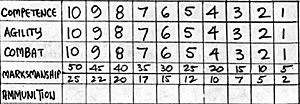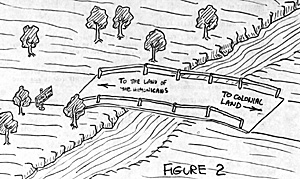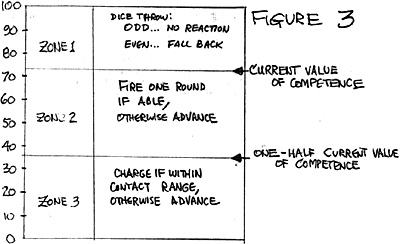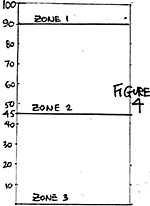Readers will remember the very erudite and seminal article in the REVIEW titled ALAS POOR OSMAN ( March 1985 ) in which the adventures of Osman the Skull Smasher were detailed.
John Grossman, author of THE COMPLETE BRIGADIER, gave us an idea about slipping into the regular gaming sequence a series of automatic responses between units ... sort of setting up sequences within sequences.
THE COMPLETE BRIGADIER employs this sort of system... units are programmed to impact upon one another whenever certain situations occur. John is experimenting with another set of rules, and we thought we'd try our hand at it using single figure skirmish rules.
First, the data sheet. Each man has 4 attributes as shown in the figure. Rummaging through my thesaurus, I came across the all-encompassing factor "COMPETENCE" .. and so we start out with a COMPETENCE factor of 10.
 Next, the attribute AGILITY is also given 10 points.
Next, the attribute AGILITY is also given 10 points.
After AGILITY, there are 2 factors which track together: COMBAT and MARKSMANSHIP. Both of these deal with weapon expertise and boxes are always crossed off these factors in tandem, i.e., a decrease in one is always accompanied by a decrease in the other.
COMBAT starts with 10 points, whereas MARKSMANSHIP may start with either a 50 (good shot) or 25 (poor shot). Whichever MARKSMANSHIP row is not used should immediately be crossed off.
Lastly, we have AMMUNITION. In the scenario to be described, American Colonials versus Indians, Ranger Grit Steele started out with an AMMUNITION supply of 15 rounds. On the other side, that great Himonican warrior, Pythagoras, commenced with only 6 rounds.
 Ranger Grit's mission was to guide a small party of 3 into Indian
country. The 4 Colonials started the game on the bridge of Figure 2, which
spanned the creek separating Indian country from non-Indian country. A5
things worked out, 6 Indians bushwacked the Colonials, who never really
got a foothold off the bridge.
Ranger Grit's mission was to guide a small party of 3 into Indian
country. The 4 Colonials started the game on the bridge of Figure 2, which
spanned the creek separating Indian country from non-Indian country. A5
things worked out, 6 Indians bushwacked the Colonials, who never really
got a foothold off the bridge.
Grit's companions were Lt. Hambone and Sgt. Mushe of the British Army, plus a young Colonial lad named Bunsen Burner.
Bunsen is a tall, lanky fellow... he's actually a 30mm figure mixed in with an assortment of 25mm figures ... who gave a startling good account of himself ... but we'll get to that. I
The action commenced when the Indian Pythagoras (an old Himonican name) fired a shot at Ranger Grit. Each turn, a man may voluntarily fire up to 3 rounds. The probability of hit is:
- P= [20 x (No of Rounds)] + MARKSMANSHIP - RANGE
Pythagoras, who was 8 inches from Grit, chose to fire 3 rounds:
- P= [20x3]+25 - 8 = 77%
It should be noted that only one of the 6 Indians, Big Honkus by name, was a marksman (MARKSMANSHIP = 50); the other 5, Including Pythagoras, had an initial MARKSMANSHIP factor of 25.
Pythagoras' first volley hit Grit, and the dice were rolled-again to see which attribute was affected:
- Dice Throw : Affected Area
01 - 33 COMPETENCE
34 - 67 AGILITY
68 - 100 Weapon Expertise MARKSMANSHIP and COMBAT
The same dice throw served to determine the extent of the injury:
- Dice Throw
Odd One box crossed off
Even Two boxes
doubles Three boxes
Grit was hit--smack in his COMPETENCE; one box was crossed off and he tested his MORALE. A morale check is accomplished by rolling two 10-sided dice; their sum must be less than or equal to the sum of the man's COMPETENCE and AGILITY factors ...
- Sum of dice less than or equal to COMPETENCE + AGILITY
Grit's COMPETENCE was 9, his AGILITY was still 10, and the total being 19, he easily passed his MORALE test.
 Having passed that, he now checked his REACTION, and this is where
the rules go off on their own, for the REACTION test starts a cycle
within a cycle. The key factor is the current value of COMPETENCE
which is multiplied by 10 (to produce a percentage figure):
Having passed that, he now checked his REACTION, and this is where
the rules go off on their own, for the REACTION test starts a cycle
within a cycle. The key factor is the current value of COMPETENCE
which is multiplied by 10 (to produce a percentage figure):
Grit's COMPETENCE level was 9, and 10 x 9 - 90. Half of that is 45, hence Grit's REACTION chart looked like that in Figure 4.
Grit's REACTION dice throw was a 54 resulting in a Zone 2 REACTION; he fired one round at Pythagoras:
- P= 20(1)+ 50 - 8 = 62%
He missed, but having been fired at, Pythagoras now check his REACTION.
The result was that the Indian fired back and Ranger Grit and Pythagoras exchanged several shots before the firefight ended.
Each turn, the men reacted to their opponent's attempts to impact upon them, and it was fascinating to see the little fellas take things into their own hands, fire shot for shot, or, irritated beyond all caring, run forward to swing at the enemy.
The REACTION sequence was triggered by one of 3 events:
- a. Whenever a man was fired at. If he was hit, he took& MORALE
check, and if he passed that, he tested his REACTION. If he wasn't
hit, he tested REACTION immediately.
b. Whenever someone attempted to close to contact with a man.
c. Whenever someone advanced to within a man's charge distance.
 Bunsen Burner was fired upon by one of the Indians and his REACTION
was to quickly fire back. Neither round took effect, but the result was
to start a small skirmish in itself, during which 3 different Indians
charged forward and were each beaten in hand-to-hand combat by Bunsen.
Bunsen Burner was fired upon by one of the Indians and his REACTION
was to quickly fire back. Neither round took effect, but the result was
to start a small skirmish in itself, during which 3 different Indians
charged forward and were each beaten in hand-to-hand combat by Bunsen.
This was the highlight of the Colonial cause; despite this temporary setback, the Indians quickly rallied and the Colonials retired to the side of the bridge from which they started.
With only 6 or 7 rounds each, the Indians quickly ran out of ammunition, and in the last phases of the game, were forced into a series of charges to drive the Colonials back. For the most part, the Indians were successful... only Bunsen's 3-in-a-row spoiled the Indian attempts.
With a name like Grit Steele, Ranger Grit was obviously the first target to be potted by the Indians. Several volleys directed at Grit, followed by single shot exchanges prompted by the REACTION of the individuals involved, reduced Grit's COMPETENCE and AGILITY to about 6 points each.
Unhappily, Ranger Grit's attempt to pass his MORALE test failed The sum of COMPETENCE and AGILITY being 12, Grit had to total under that amount with two 10-sided dice... Ranger Grit just wasn't up to it, and back across the bridge he ran. He eventually recovered, however, and ran back into the fray again.
The Colonial fight was essentially carried on by Sgt Mushe, who continuously gave tit foi- tat, upholding the honor of the British Army, especially after he saw his peerless leader, young Lt. Hambone, take off and run.
Lt. Harnbone really couldn't be blamed for his lapse. The Lieutenant wasn't even equipped with a firearm, and whenever anyone aimed a musket at him and squeezed the trigger, the REACTION table caused him to raise his cutlass on high, shout "Charge!", and surge forward.
Several such surges produced several wounds which evidenced themselves in lower COMPETENCE and AGILITY factors. The result eventually caused Lt. Hambone to take to his heels.
The unfortunate part of the Lieutenant's rout was that he failed to recover, and since each time he failed his MORALE test another box was crossed off - each of his attributes, it became more and more difficult to pass. The upshot was that Lt. Hambone ran well back to safety, hurting in mind, body, and spirit. "Twill be some time before the lad recovers."
The REACTION sequence ran quite well. Each shot triggered an exchange of gunfire; sometimes 3 or 4 shots rang out before the fight broke off. Similarly, an advance to contact oe to within someone's charge range triggered defensive fire or a countercharge.
In all, therefore, we were pleased with the results, even though the REACTION table might be termed "primitive". More later on this, as we bring the rules out of the stone age.
Back to PW Review June 1985 Table of Contents
Back to PW Review List of Issues
Back to MagWeb Master Magazine List
© Copyright 1985 Wally Simon
This article appears in MagWeb (Magazine Web) on the Internet World Wide Web.
Other military history articles and gaming articles are available at http://www.magweb.com